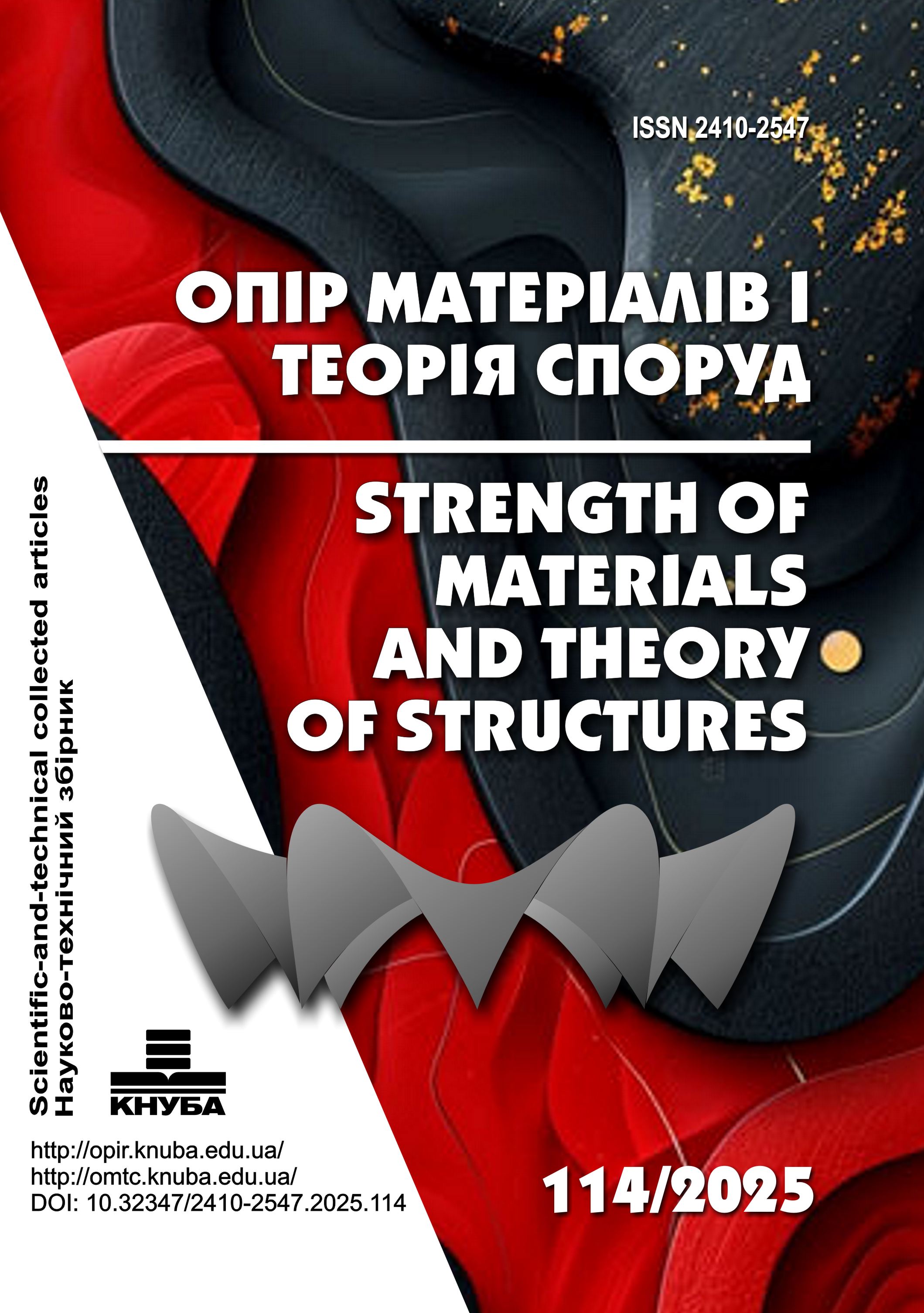Tuning of vibro-impact nonlinear energy sinks under changing structural parameters. Part 1
DOI:
https://doi.org/10.32347/2410-2547.2025.114.11-22Keywords:
nonlinear energy sink, damper, vibro-impact, optimized parameters, efficiency, bilateral impactsAbstract
This paper studies the efficiency of vibro-impact nonlinear energy sink, that is, vibro-impact damper, in mitigating the primary structure vibrations, i.e., in reducing its total mechanical energy. The primary structure is a linear oscillator that forms a strongly nonlinear vibro-impact system when a vibro-impact damper is coupled to it. When the damper is tuned to a certain value of a structural parameter, in particular, the primary structure damping, its sufficiently high efficiency is maintained in some this parameter range and deteriorates in a wider range. Then tuning the damper design to the appropriate value of the primary structure damping allows to significantly improve its efficiency. Optimization procedures are carried out by the tools of standard software Matlab. However, the optimized parameters of the low-mass damper acquire unusual “strange” values, namely, very large clearance and small damping coefficient. In addition, the areas of bilateral damper impacts both directly on the primary structure and on the obstacle are narrow; the areas of unilateral direct damper impacts on the primary structure are wider. These phenomena, observed in our previous works for one particular value of the primary structure damping, persist for its different values. It is also shown how a VI NES attachment can replace the additional PS damping. The system dynamics with the single-sided vibro-impact nonlinear energy sink coupled to the primary structure is always complex; the amplitude-modulated responses are often occur. The characteristics of such a regime are shown, namely, the time history of displacements with upper envelope, left and right contact forces, the phase portraits with Poincaré maps, and Fourier spectra. Modeling the impact using the nonlinear Hertz’s contact force in accordance with his quasi-static theory allows us to calculate the impact contact forces, take into account and optimize the characteristics of the colliding surfaces.
Qualitative figures and tables accompany a large volume of numerical experiments.
References
Saeed A.S., Abdul Nasar R., Al-Shudeifat M.A. A review on nonlinear energy sinks: designs, analysis and applications of impact and rotary types // Nonlinear Dynamics. – 2022. – Т. 111, № 1. – С. 1–37. DOI: 10.1007/s11071-022-08094-y.
Saeed A.S., AL-Shudeifat M.A., Cantwell W.J., Vakakis A.F. Two-dimensional nonlinear energy sink for effective passive seismic mitigation // Communications in Nonlinear Science and Numerical Simulation. 2021. Vol. 99. P. 105787. DOI: 10.1016/j.cnsns.2021.105787.
Lu Z., Wang Z., Zhou Y., Lu X. Nonlinear dissipative devices in structural vibration control: A review // Journal of Sound and Vibration. – 2018. – Т. 423. – С. 18–49. DOI:10.1016/j.jsv.2018.02.052 .
Lu Z., Wang Z., Masri S. F., Lu X. Particle impact dampers: Past, present, andfuture // Structural Control and Health Monitoring. – 2017. – Т. 25, № 1. – С. e2058. DOI: 10.1002/stc.2058
Wang J., Wierschem N. E., Spencer B. F., Lu X. Track nonlinear energy sink for rapid response reduction in building structures // Journal of Engineering Mechanics. – 2015. – Т. 141, № 1. DOI: 10.1061/(ASCE)EM.1943-7889.000082
Wierschem N. E., Spencer B. F. Jr. Targeted energy transfer using nonlinear energy sinks for the attenuation of transient loads on building structures // Tech. Rep. 045. – Newmark Structural Engineering Laboratory, University of Illinois at Urbana-Champaign, 2015. – Режим доступу: https://www.ideals.illinois.edu/items/89701.
Wang Y., Zhang J., Wang W., Wang Z., Hong J., Fang B. Research on the influence of finite contact stiffness on vibration reduction of a vibro-impact nonlinear energy sink system // International Journal of Non-Linear Mechanics. – 2025. – Т. 170. – С. 104991. DOI:10.1016/j.ijnonlinmec.2024.104991 .
Lizunov P., Pogorelova O., Postnikova T. Comparative Analysis of Performance of Single-sided and Double-sided Vibro-Impact Dampers // NODYCON2025. – Under Review.
Lizunov P., Pogorelova O., Postnikova T. Features of different variants for optimal design of vibro-impact nonlinear energy sinks affectingt heir efficiency and dynamics. – 2025. – DOI: 10.2139/ssrn.5179053.
Wierschem N. E., Hubbard S. A., Luo J., Fahnestock L. A., Spencer B. F., McFarland D. M., Quinn D. D., Vakakis A. F., Bergman L. A. Response attenuation in a large-scale structure subjected to blast excitation utilizing a system of essentially nonlinear vibration absorbers // Journal of Sound and Vibration. – 2017. – Т. 389. – С. 52–72. DOI: 10.1016/j.jsv.2016.11.003 .
Li T., Seguy S., Berlioz A. On the dynamics around targeted energy transfer for vibro-impact nonlinear energy sink // Nonlinear Dynamics. – 2016. – Т. 87, № 3. – С. 1453–1466. DOI: 10.1007/s11071-016-3127-0.
AL-Shudeifat M. A., Wierschem N., Quinn D. D., Vakakis A. F., Bergman L. A., Spencer B. F. Numerical and experimental investigation of a highly effective single-sided vibro-impact non-linear energy sink for shock mitigation // International Journal of Non-Linear Mechanics. – 2013. – Т. 52. – С. 96–109. DOI: 10.1016/j.ijnonlinmec.2013.02.004.
Johnson K. L. Contact Mechanics. – 1985. DOI: 10.1017/cbo9781139171731 .
Bazhenov V., Pogorelova O., Postnikova T. Crisis-Induced Intermittency and Other Nonlinear Dynamics Phenomena in Vibro-impact System with Soft Impact // Non linear Mechanics of Complex Structures. – 2021. – С. 185–203. DOI: 10.1007/978-3-030-75890-5_11.
Lizunov P., Pogorelova O., Postnikova T. Optimization of a vibro-impactdamperdesignusing MATLAB tools // Strength of Materials and Theory of Structures. – 2024. – Issue 112. – С. 3–18. DOI: 10.32347/2410-2547.2024.112.3-18.
Housner G. W., Bergman L. A., Caughey T. K., Chassiakos A. G., Claus R. O., Masri S. F., Skelton R. E., Soong T. T., Spencer B. F., Yao J. T. P. Structural control: past, present, and future // Journal of Engineering Mechanics. – 1997. – Т. 123, № 9. – С. 897–971. DOI: 10.1061/(ASCE)0733-9399(1997)123:9(897).
Downloads
Published
Issue
Section
License

This work is licensed under a Creative Commons Attribution 4.0 International License.
Authors retain copyright and grant the journal right of first publication with the work simultaneously licensed under a Creative Commons Attribution License that allows others to share the work with an acknowledgement of the work's authorship and initial publication in this journal.

